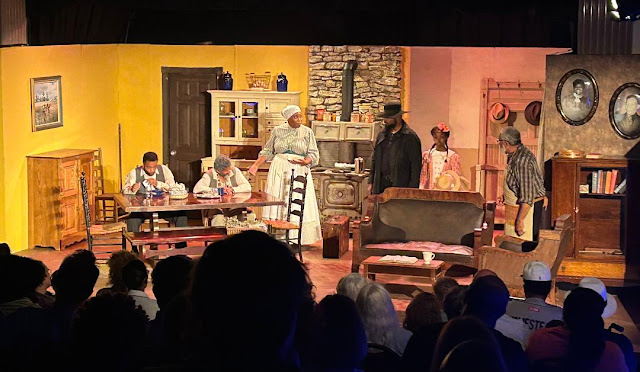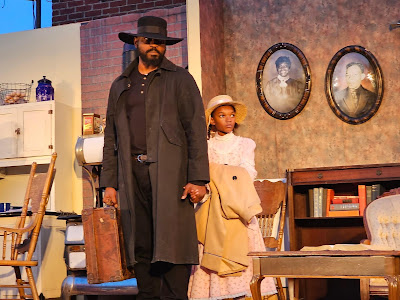 |
Maurice Redwood (Jeremy), Mike Traylor (Bynum Walker), Shaunda Miles McDill (Bertha Holly), Roosevelt Watts Jr (Harold Loomis), Adjoa Opoku-Dakwa (Zonia Loomis) & Kevin Brown (Seth Holly). Credit all photos: Mark Clayton Southers |
Some may call it a
stretch, but I liken August Wilson’s opus Joe Turner’s Come and Gone to
Beethoven’s “Ninth Symphony” and Mahler’s “Eighth Symphony.” All three are
large scale, complex, powerful works, considered to be the cream of their
makers’ crop.
Writing for a
large cast of 11, Wilson eases into each character with such definition and
delineation, that it’s easy to develop a mental sketch of their personalities
and keep each one distinct from the onset.
The play opens
with husband and wife, Seth Holly (Kevin Brown) and Bertha Holly (Shaunda Miles
McDill) in the kitchen of their Hill District boarding house, a Pittsburgh
landmark for African Americans making their way north from the sharecropper,
Jim Crow ways of the South looking for a better life.
Seth is an odd man
out because he’s actually a native Northerner, having been born and raised in
Pittsburgh and now living in his parents’ house.
Cantankerous and
judgmental, Seth speaks words that are often rash and biting. As his
long-suffering, gentle and motherly wife, Bertha, she patiently listens to his opinions but has an arsenal of clever
retorts that most often hit their mark. As she serves her boarders her
breakfast biscuits and Sunday dinner fried chicken, she does so with a gentle
kindheartedness I found very appealing.
One of the
long-standing boarders, Bynum Walker (Mike Traylor) is an eccentric medicine
man who cavorts with pigeons and collects herbs to carry out his shamanistic
rituals to heal and “bind” people in need of his remedies.
Traylor is the
most colorful of all the characters, proposing mystical ideas that Seth finds
off-putting, but the other characters consider with various degrees of
credibility or skepticism. Disregarding his arcane belief system, his is often
the voice of reason and whose ways provide some of the plays most jocular
moments.
 |
L-R Mike Traylor as Bynum Walker & Maurice Redwood as Jeremy |
Another character
with a genial demeanor, Jeremy Furlow (Maurice Redwood) is a ladies man with an
itch to travel and a lust for life. His recent arrest for drunkenness
(questions of police profiling and harassment arise) alienates his landlord who
warns that his is a proper, respectable boarding house.
Jeremy proceeds to
arrange an affair with Mattie Campbell (Dominique Briggs), who visits the house
to engage Bynum’s aid to help her find her man who’s just run off. Before long,
Jeremy’s attention turns to a resident newcomer, Molly Cunningham (Jamaica
Johnson), an independent woman whose self-assertion and confidence is more than
match to Jeremy’s manipulations.
In a play about
relationships, budding and/or fractured, Rutherford Selig (Marcus Muzopappa)
affords the Hollys a mutually advantageous economic arrangement, selling the
pans Seth makes as he makes his rounds of the area as an itinerant peddler. He
also is known as a finder of people, a service for which he charges a small
fee.
 |
L-R Roosevelt Watts Jr as Harold Loomis & Saniya Lavelle as Zonia Loomis Photo by Chuck Timbers |
Into this group of
basically even-tempered but needy people comes a foreboding figure in the form
of Herald Loomis (Roosevelt Watt, Jr.), a tall, physically powerful man dressed
in a long black coat and wide-brimmed hat, despite the hot summery weather
outside.]
At his side is his
young daughter, Zonia (Saniya Lavelle). Both are on a quest to find their
wife/mother, separated after Herald was snatched up by a bounty hunter and
forced onto a chain gang down South for seven years. Now free, he’s headed
north to find the missing woman with his daughter in hand.
Set in 1911, Joe
Turner is the second of Wilson’s ten works that chronicle the African American
experience in the 20th century through each of the century‘s ten decades. Joe
Turner is both the man responsible for Herald’s seven-year long period of
servitude as well as the play’s message to find, as Bynam calls it, your “inner
song,” or sense of self in the post-slavery era.
Wisely, Wilson
wrote narrative for two young children, Zonia, and the boy next door, Ruben
Mercer (Cameron Edwards) who give the dramatic experience, sometimes heavy with
darker moods, several lighthearted breaks. The two youngsters form an immediate
friendship with Ruben soon developing a childhood crush on the girl.
As Zonia, Saniya
J.E. Lavelle had the more challenging role, having to emote a variety of
dramatic episodes, a task she carried off with amazing ability.
One scene that
particularly alerted me to Wilson’s power of the pen takes place in Act Two. It
begins around the kitchen table with an infectious joke that ignites a bout of
laughter followed by everyone getting up and dancing a spirited “juba” that
verges on Pentecostal jubilation.
The episode soon
collapses into a dark place when Herald is severely affected and undergoes a
terrifying, homicidal rage. The facile way in which Wilson scripts the
emotional transition from happy and benign to horror and dismay is simply
amazing.
 |
| L-R Roosevelt Watts Jr as Harold Loomi & Karla Payne as Martha Pentecost |
The play’s
resolution comes about when Herald’s long-lost wife, Martha Pentecost (Karla
Payne), arrives at the house. Past wounds are addressed, and Herald experiences
an epiphany, one you might not expect.
When I heard the
play ran close to two hours and 45 minutes (including intermission), I felt a
bit of concern that my attention span might not be up to the task at hand. But,
as I explained to director, Mark Clayton Southers, after the audience’s
standing ovation, I was so wrapped up in the experience, time just seemed to
fly by and my interest never wavered.
At this point,
I’ve seen six or seven plays in Wilson’s American Century Cycle. Joe Turner has
to be my current favorite. It’s accessible, interesting, packed with a variety
of emotions, insights into the African American experience, a cultural
documentary of sorts presented in dramatic form, a learning experience and
something loaded with entertainment value.
A co-production of
Pittsburgh Playwright Theatre Company and the August Wilson House, Joe Turner’s
Come and Gone ran from August 5 through September 10 at the August Wilson
House, 1727 Bedford Avenue in Pittsburgh‘s Hill District. For more information
on PPTC’s upcoming productions, visit website https://www.pghplaywrights.org.
Comments
Post a Comment